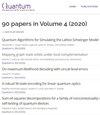Fault-tolerant hyperbolic Floquet quantum error correcting codes
IF 5.1
2区 物理与天体物理
Q1 PHYSICS, MULTIDISCIPLINARY
引用次数: 0
Abstract
A central goal in quantum error correction is to reduce the overhead of fault-tolerant quantum computing by increasing noise thresholds and reducing the number of physical qubits required to sustain a logical qubit. We introduce a potential path towards this goal based on a family of dynamically generated quantum error correcting codes that we call "hyperbolic Floquet codes.'' These codes are defined by a specific sequence of non-commuting two-body measurements arranged periodically in time that stabilize a topological code on a hyperbolic manifold with negative curvature. We focus on a family of lattices for $n$ qubits that, according to our prescription that defines the code, provably achieve a finite encoding rate $(1/8+2/n)$ while still requiring only two-body measurements. Similar to hyperbolic surface codes, the distance of the code at each time-step scales at most logarithmically in $n$. The family of lattices we choose indicates that this scaling is achievable in practice. We develop and benchmark an efficient matching-based decoder that provides evidence of a threshold near 0.1% in a phenomenological noise model and 0.25% in an entangling measurements noise model. Utilizing weight-two check operators and a qubit connectivity of 3, one of our hyperbolic Floquet codes uses 400 physical qubits to encode 52 logical qubits with a code distance of 8, i.e., it is a $[[400,52,8]]$ code. At small error rates, comparable logical error suppression to this code requires 5x as many physical qubits (1924) when using the honeycomb Floquet code with the same noise model and decoder.容错双曲Floquet量子纠错码
量子纠错的一个中心目标是通过提高噪声阈值和减少维持逻辑量子位所需的物理量子位的数量来减少容错量子计算的开销。我们引入了一种实现这一目标的潜在途径,该途径基于一组动态生成的量子纠错码,我们称之为“双曲Floquet码”。这些码是由特定的非交换二体测量序列定义的,这些测量序列在时间上周期性地排列,稳定了负曲率双曲流形上的拓扑码。我们专注于$n$量子比特的晶格族,根据我们定义代码的处方,可以证明实现有限的编码率$(1/8+2/n)$,同时仍然只需要两体测量。与双曲曲面码类似,码在每个时间步长的距离最多以n为对数。我们选择的格族表明,这种缩放在实践中是可以实现的。我们开发并测试了一种高效的基于匹配的解码器,该解码器在现象学噪声模型中提供了接近0.1%的阈值,在纠缠测量噪声模型中提供了0.25%的阈值。我们的一个双曲Floquet码利用权-二校验算子和3个量子比特连性,使用400个物理量子比特编码52个逻辑量子比特,码距为8,即$[[400,52,8]]$码。在较小的错误率下,当使用具有相同噪声模型和解码器的蜂窝Floquet代码时,与此代码相比较的逻辑错误抑制需要5倍的物理量子位(1924)。
本文章由计算机程序翻译,如有差异,请以英文原文为准。
求助全文
约1分钟内获得全文
求助全文
来源期刊

Quantum
Physics and Astronomy-Physics and Astronomy (miscellaneous)
CiteScore
9.20
自引率
10.90%
发文量
241
审稿时长
16 weeks
期刊介绍:
Quantum is an open-access peer-reviewed journal for quantum science and related fields. Quantum is non-profit and community-run: an effort by researchers and for researchers to make science more open and publishing more transparent and efficient.
 求助内容:
求助内容: 应助结果提醒方式:
应助结果提醒方式:


